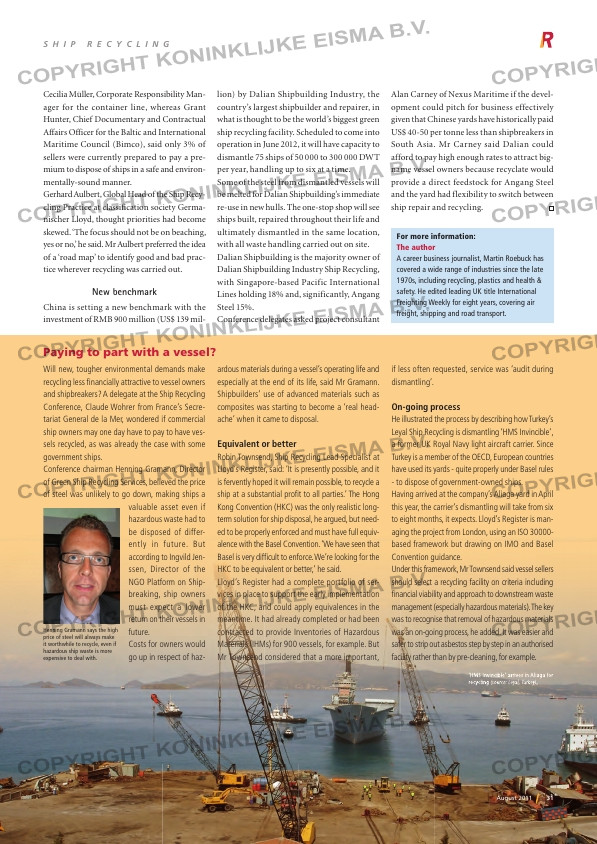Page 31 from: August 2011

S H I P R E C Y C L I N G
Cecilia Müller, Corporate Responsibility Man-
ager for the container line, whereas Grant
Hunter, Chief Documentary and Contractual
Affairs Officer for the Baltic and International
Maritime Council (Bimco), said only 3% of
sellers were currently prepared to pay a pre-
mium to dispose of ships in a safe and environ-
mentally-sound manner.
Gerhard Aulbert, Global Head of the Ship Recy-
cling Practice at classification society Germa-
nischer Lloyd, thought priorities had become
skewed. ‘The focus should not be on beaching,
yes or no,’ he said. Mr Aulbert preferred the idea
of a ‘road map’ to identify good and bad prac-
tice wherever recycling was carried out.
New benchmark
China is setting a new benchmark with the
investment of RMB 900 million (US$ 139 mil-
lion) by Dalian Shipbuilding Industry, the
country’s largest shipbuilder and repairer, in
what is thought to be the world’s biggest green
ship recycling facility. Scheduled to come into
operation in June 2012, it will have capacity to
dismantle 75 ships of 50 000 to 300 000 DWT
per year, handling up to six at a time.
Some of the steel from dismantled vessels will
be melted for Dalian Shipbuilding’s immediate
re-use in new hulls. The one-stop shop will see
ships built, repaired throughout their life and
ultimately dismantled in the same location,
with all waste handling carried out on site.
Dalian Shipbuilding is the majority owner of
Dalian Shipbuilding Industry Ship Recycling,
with Singapore-based Pacific International
Lines holding 18% and, significantly, Angang
Steel 15%.
Conference delegates asked project consultant
Alan Carney of Nexus Maritime if the devel-
opment could pitch for business effectively
given that Chinese yards have historically paid
US$ 40-50 per tonne less than shipbreakers in
South Asia. Mr Carney said Dalian could
afford to pay high enough rates to attract big-
name vessel owners because recyclate would
provide a direct feedstock for Angang Steel
and the yard had flexibility to switch between
ship repair and recycling.
For more information:
The author
A career business journalist, Martin Roebuck has
covered a wide range of industries since the late
1970s, including recycling, plastics and health &
safety. He edited leading UK title International
Freighting Weekly for eight years, covering air
freight, shipping and road transport.
Paying to part with a vessel?
31August 2011
‘HMS Invincible’ arrives in Aliaga for
recycling (source: Leyal, Turkey).
Will new, tougher environmental demands make
recycling less fi nancially attractive to vessel owners
and shipbreakers? A delegate at the Ship Recycling
Conference, Claude Wohrer from France’s Secre-
tariat General de la Mer, wondered if commercial
ship owners may one day have to pay to have ves-
sels recycled, as was already the case with some
government ships.
Conference chairman Henning Gramann, Director
of Green Ship Recycling Services, believed the price
of steel was unlikely to go down, making ships a
valuable asset even if
hazardous waste had to
be disposed of differ-
ently in future. But
according to Ingvild Jen-
ssen, Director of the
NGO Platform on Ship-
breaking, ship owners
must expect a lower
return on their vessels in
future.
Costs for owners would
go up in respect of haz-
ardous materials during a vessel’s operating life and
especially at the end of its life, said Mr Gramann.
Shipbuilders’ use of advanced materials such as
composites was starting to become a ‘real head-
ache’ when it came to disposal.
Equivalent or better
Robin Townsend, Ship Recycling Lead Specialist at
Lloyd’s Register, said: ‘It is presently possible, and it
is fervently hoped it will remain possible, to recycle a
ship at a substantial profi t to all parties.’ The Hong
Kong Convention (HKC) was the only realistic long-
term solution for ship disposal, he argued, but need-
ed to be properly enforced and must have full equiv-
alence with the Basel Convention. ‘We have seen that
Basel is very diffi cult to enforce. We’re looking for the
HKC to be equivalent or better,’ he said.
Lloyd’s Register had a complete portfolio of ser-
vices in place to support the early implementation
of the HKC, and could apply equivalences in the
meantime. It had already completed or had been
contracted to provide Inventories of Hazardous
Materials (IHMs) for 900 vessels, for example. But
Mr Townsend considered that a more important,
if less often requested, service was ‘audit during
dismantling’.
On-going process
He illustrated the process by describing how Turkey’s
Leyal Ship Recycling is dismantling ‘HMS Invincible’,
a former UK Royal Navy light aircraft carrier. Since
Turkey is a member of the OECD, European countries
have used its yards – quite properly under Basel rules
– to dispose of government-owned ships.
Having arrived at the company’s Aliaga yard in April
this year, the carrier’s dismantling will take from six
to eight months, it expects. Lloyd’s Register is man-
aging the project from London, using an ISO 30000-
based framework but drawing on IMO and Basel
Convention guidance.
Under this framework, Mr Townsend said vessel sellers
should select a recycling facility on criteria including
fi nancial viability and approach to downstream waste
management (especially hazardous materials). The key
was to recognise that removal of hazardous materials
was an on-going process, he added. It was easier and
safer to strip out asbestos step by step in an authorised
facility rather than by pre-cleaning, for example.
Henning Gramann says the high
price of steel will always make
it worthwhile to recycle, even if
hazardous ship waste is more
expensive to deal with.
p026_Ship Recycling.indd 31 04-08-11 09:36



